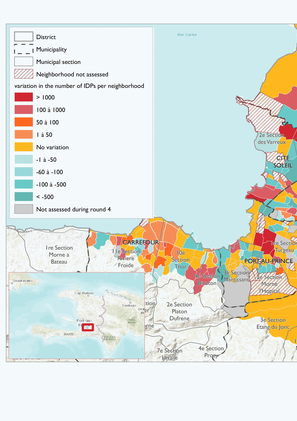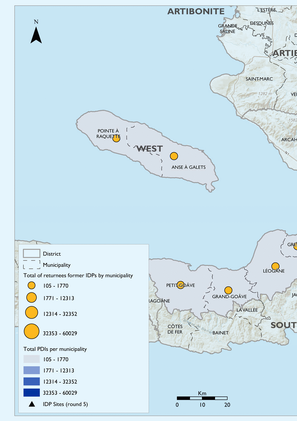-
Countries
-
Data and Analysis
-
Special Focus
-
Crisis Responses
Site Assessment
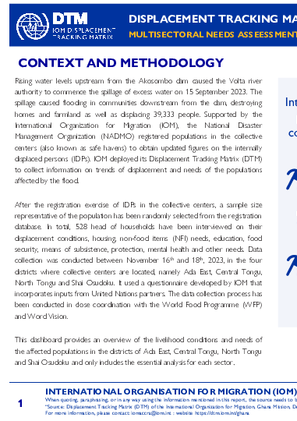
Contact
iomaccra@iom.int
Language
English
Location
Ghana
Period Covered
Nov 16 2023
Nov 18 2023
Activity
- Survey
- Site Assessment
Rising water levels upstream from the Akosombo dam caused the Volta river authority to commence the spillage of excess water on 15 September 2023. The spillage caused flooding in communities downstream from the dam, destroying homes and farmland as well as displacing 39,333 people. Supported by the International Organization for Migration (IOM), the National Disaster Management Organization (NADMO) registered populations in the collective centers (also known as safe havens) to obtain updated figures on the internally displaced persons (IDPs). IOM deployed its Displacement Tracking Matrix (DTM) to collect information on trends of displacement and needs of the populations affected by the flood.
After the registration exercise of IDPs in the collective centers, a sample size representative of the population has been randomly selected from the registration database. In total, 528 head of households have been interviewed on their displacement conditions, housing, non-food items (NFI) needs, education, food security, means of subsistence, protection, mental health and other needs. Data collection was conducted between November 16th and 18th, 2023, in the four districts where collective centers are located, namely Ada East, Central Tongu, North Tongu and Shai Osudoku. It used a questionnaire developed by IOM that incorporates inputs from United Nations partners. The data collection process has been conducted in close coordination with the World Food Programme (WFP) and Word Vision.
This dashboard provides an overview of the livelihood conditions and needs of the affected populations in the districts of Ada East, Central Tongu, North Tongu and Shai Osudoku and only includes the essential analysis for each sector.
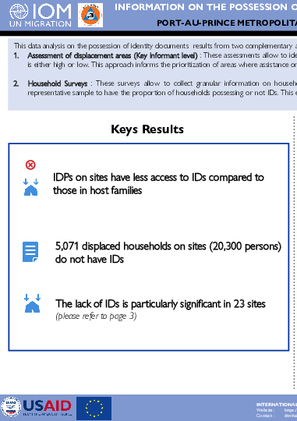
Contact
DTM Haiti, dtmhaiti@iom.int
Language
English
Location
Haiti
Period Covered
Oct 09 2023
Oct 20 2023
Activity
- Survey
- Mobility Tracking
- Site Assessment
- Baseline Assessment
- Village Assessment
This data analysis on the possession of identity documents results from two complementary approaches: 1. Assessment of displacement areas (Key Informant level) : These assessments allow to identify areas (host families and displacement sites) where the possession of identity documents (IDs) is either high or low. This approach informs the prioritization of areas where assistance on IDs’ issuance is most needed. 2. Household Surveys : These surveys allow to collect granular information on household level. Whereas the first methodology informs prioritization of areas, surveys allow from a representative sample to have the proportion of households possessing or not IDs. This eventually allowing to define the number of potential beneficiaries of assistance of IDs' issuance.
Results indicate that IDPs on sites have less access to IDs compared to those in host families, 5,071 displaced households on sites (20,300 persons) do not have IDs, the lack of IDs is particularly significant in 23 sites

Contact
DTM Papua New Guinea, iompngmdac@iom.int
Language
English
Location
Papua New Guinea
Period Covered
Nov 22 2023
Nov 30 2023
Activity
- Mobility Tracking
- Site Assessment
- Baseline Assessment
On 20 November 2023, Mount Ulawun volcano on the border of the West New Britain (WNB) and East New Britain (ENB) provinces erupted, spewing ash plumes. The Rabaul Volcanological Observatory reported that seismicity was high, showing an upward trend but at a reduced rate and thus recommended that the Alert Level be upgraded to Stage 4. The volcano eruption caused mass displacement across the affected areas. IOM’s Displacement Tracking Matrix (DTM) site assessment tool was rolled out in WNB and ENB within a week following the eruption and identified 8,565 persons (1,707 Households [HH]) displaced from the local villages in WNB and ENB.1 Another 8,544 displaced individuals (private sector companies’ evacuees) are hosted by their employers (Hargy Oil Palm and Navo Mill) in WNB and are not accounted for in the DTM assessment. Combined, the total number of displaced persons, company evacuees and local villagers, is 17,109. The situation remains fluid and information presented in this report may continue to evolve.
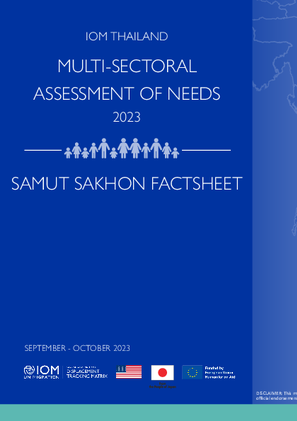
Contact
DTMThailand@iom.int
Language
English
Location
Thailand
Period Covered
Sep 30 2023
Oct 23 2023
Activity
- Survey
- Site Assessment
This factsheet aims to provide a snapshot of multi-sectoral conditions, needs, and challenges among Myanmar migrants in Samut Sakhon province as captured between September and October 2023 by IOM Thailand’s multisectoral assessment of needs. The purpose of this assessment is to provide insights regarding the severity of needs among migrant populations, identify vulnerable population groups and geographic areas with the most acute needs, inform assistance planning and relevant Sustainable Development Goals (SDGs) targets, and provide sectoral and inter-sectoral baselines for future assessments.
Contact
DTM Mozambique, DTMMozambique@iom.int
Location
Mozambique
Activity
- Mobility Tracking
- Site Assessment
Period Covered
Jul 12 2023 -Aug 04 2023
A site assessment is a sub-component of mobility tracking. It aims to collect data on population presence, living conditions and needs in a particular displacement site or community.
Population Groups
IDPs
Survey Methodology
Unit of Analysis Or Observation
Site
Type of Survey or Assessment
Key Informant
Keywords
Geographical Scope Partial Coverage
Administrative boundaries with available data
The current dataset covers the following administrative boundaries

Contact
Daniel Tagoe: DTagoe@iom.int
Language
English
Location
Ghana
Period Covered
Oct 19 2023
Nov 22 2023
Activity
- Site Assessment
The Volta Region in Ghana has experienced heavy rains and high inflows of water to the Akosombo and Kpong dam reservoir, leading to severe flooding that has displaced 39,333 people in 9 districts. Infrastructure, crops, and shelters have been damaged, and access to essential services has been disrupted. Between 19th and 22nd October 2023, the Inter-Agency Emergencies Working Group in Ghana (IAEWG) conducted a rapid needs assessments due to the floods in collaboration with the National Disaster Management Organization (NADMO). The assessment focused on 2 districts (Central Tongu and North Tongu) and specifically in 9 safe havens (collective centers hosting Internally Displaced Persons, IDPs). Both districts have been severely impacted by the floods and currently host 75 per cent of the displaced population. The assessment team assessed 4 collective centers in Central Tongu (New Bakpa, Afetorgborkope, Farm Institute, Lunchtorkor) and 5 in North Tongu (Mepe Presby Junior High School [JHS], Mepe JHS, Mepe Presby Primary School, RC Primary school, Saint kizito). Collective centers were selected in coordination with NADMO based on two criterias: the accessibility and the highest number of IDPs.
Prior to the assessment in the collective centers, interviews have been conducted with NADMO regional directors in order to get an overview of the situation in the 9 districts. Through a network of 9 key informants and NADMO local field agents, in close coordination with IAWGE and local authorities on the ground, 9 interviews have been conducted, as well as 29 focus group discussions (FDGs) with men, women, boys and girls, including person with disabilities. The focus groups discussion methodology has been validated by the participants of the Rapid Needs Assessments. FDGs with children has been done with the presence of specialized agency. The goal of the Rapid Needs Assessment was to identify needs of the displaced population, and to identify urgent humanitarian response to the floods.
This dashboard presents the results of the Rapid Needs Assessment on health, WASH, education, protection and mental health of the displaced populations living in collective centers in Volta after the flooding.

Contact
DTMThailand@iom.int
Language
English
Location
Thailand
Period Covered
Oct 01 2023
Oct 31 2023
Activity
- Mobility Tracking
- Site Assessment
- Baseline Assessment
This report provides a snapshot as of October 2023. Across 1,312 assessed locations in 116 sub-districts and 44 districts, there are an estimated 334,000 non-Thai individuals. Highlighted districts in the map to the left represent areas in which IOM has collected data. Sometimes coverage is only partial. For reference, the overall estimated population in the assessed locations is 1,470,000 individuals. Around a fifth of the non-Thai population (63,000 individuals) are reported to have arrived since the military takeover in Myanmar. The three districts with the highest presence of non-Thai individuals identified are Mae Sot (81,000 ind.) in Tak province, Mueang Ranong (55,000 ind.) in Ranong province, and Mae Sai (32,000 ind.) in Chiang Rai province.
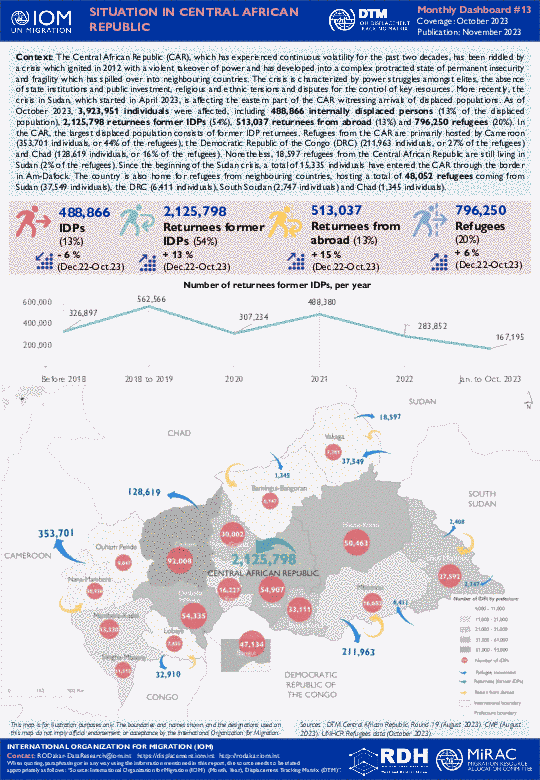
Contact
The Central African Republic (CAR), which has experienced continuous volatility for the past two decades, has been riddled by a crisis which ignited in 2012 with a violent takeover of power and has developed into a complex protracted state of permanent in
Language
English
Activity
- Mobility Tracking
- Site Assessment
- Village Assessment
The Central African Republic (CAR), which has experienced continuous volatility for the past two decades, has been riddled by a crisis which ignited in 2012 with a violent takeover of power and has developed into a complex protracted state of permanent insecurity and fragility which has spilled over into neighbouring countries. The crisis is characterized by power struggles amongst elites, the absence of state institutions and public investment, religious and ethnic tensions and disputes for the control of key resources. More recently, the crisis in Sudan, which started in April 2023, is affecting the eastern part of the CAR witnessing arrivals of displaced populations. As of October 2023, 3,923,951 individuals were affected, including 488,866 internally displaced persons (13% of the displaced population), 2,125,798 returnees former IDPs (54%), 513,037 returnees from abroad (13%) and 796,250 refugees (20%). In the CAR, the largest displaced population consists of former IDP returnees. Refugees from the CAR are primarily hosted by Cameroon (353,701 individuals, or 44% of the refugees), the Democratic Republic of the Congo (DRC) (211,963 individuals, or 27% of the refugees) and Chad (128,619 individuals, or 16% of the refugees). Nonetheless, 18,597 refugees from the Central African Republic are still living in Sudan (2% of the refugees). Since the beginning of the Sudan crisis, a total of 15,335 individuals have entered the CAR through the border in Am-Dafock. The country is also home for refugees from neighbouring countries, hosting a total of 48,052 refugees coming from Sudan (37,549 individuals), the DRC (6,411 individuals), South Soudan (2,747 individuals) and Chad (1,345 individuals).
Pagination
- Previous page
- Page 14
- Next page
